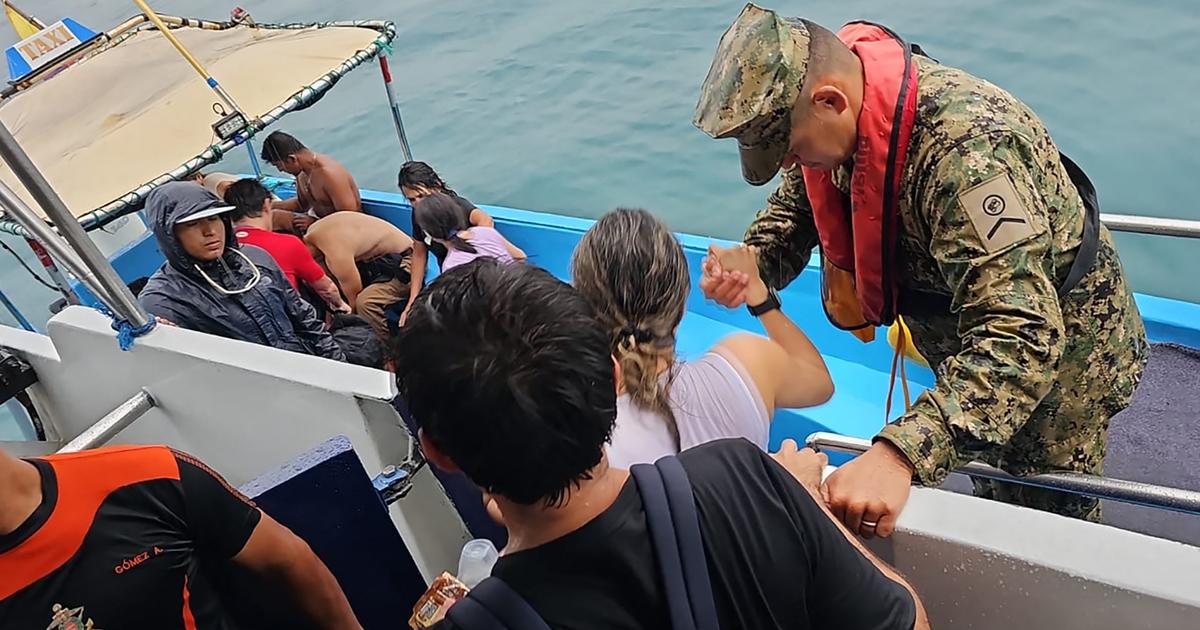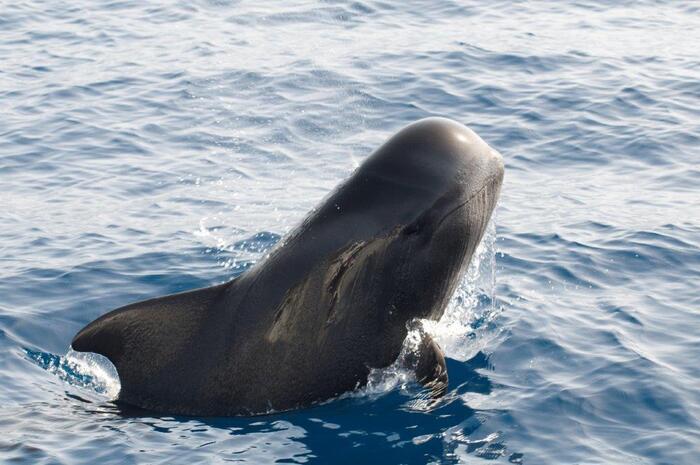The vital exuberance of the upper Amazon, on the triple border of Colombia with Peru and Brazil, has something of static.
It exudes an apparent harmony, although it hides multiple tensions in its tranquility.
MORE INFORMATION
PHOTO GALLERYA life protecting the aquatic creatures of the Amazon
Chapter IX: José Gregorio: Either we preserve the Amazon rainforest or he will take revenge
Chapter VIII: Nantu: The Solar Dream
Here, among the meanders of its abundant tributaries, which descend loaded with life, where an exceptional biodiversity proliferates in the flood of its slow waters, the pink Amazonian dolphin swims.
Since ancient times, this aquatic mammal has held a sacred place in indigenous cosmologies, as it does in many corners of the immense Amazon basin.
Also for Lilia Isolina Java Tapayuri, community leader of the Cocama ethnic group, in the Tikuna-Cocama-Yagua reservation, the pink dolphin is sacred.
And it occupies a central part in her vital and professional journey that has led her to occupy an important role today in the conservation of the fluvial fauna of this corner of the Amazon jungle.
Lilia, 35 years ago, was born in the community of San Francisco, a few miles northwest of Puerto Nariño, on the Loretoyacu River, a tributary of the Amazon, and from a young age she was attracted to the river's fauna, which has marked so much the sense of your spirituality as your professional life.
In the worldview of the indigenous peoples of the Amazonian trapezoid, in a world dominated by water, the pink dolphin reigns: an elusive creature, at once enigmatic, intelligent and coveted.
In recent times, the dolphin has become an icon of initiatives that fight to conserve the ecosystem and that have also reached this remote Amazon region.
These indigenous people, resettled far from their territory of origin in the interior of the jungle by rubber operations in the 19th century, remained by the river even when rubber prices plummeted and the enslavement of the indigenous people was abandoned.
With the arrival of messianic missionaries in the mid-20th century, they abandoned their communal dwellings, considered promiscuous by church ministers, and resettled in single-family rectangular houses with separate rooms, wooden walls, and tin roofs.
Despite evangelization, many preserved in their syncretism fragments of their ancestral mystical universe, where the world is divided into three levels, water, air and land, but where aquatic fauna plays a central role.
And it is in this context where, for Lilia, the conservation and defense of the river fauna, such as the manatee, the dolphin, the otter or the alligator, means not only defending the jungle and the biological cycle of the ecosystem, but also the ways of life of indigenous peoples and their spirituality.
see photo gallery Lilia poses for a portrait on the Amazon River.
Click on the image to see the complete photo gallery.
Pablo Albarenga
But of all the rich Amazonian aquatic fauna, it is the pink dolphin that occupies a central place in the indigenous imagination.
Lilia says that he appears in ritual celebrations as the "nipple," a painful rite of passage that involves pulling out all the girls' hair as they enter puberty.
The dolphin appears to the community as a person, always wearing attributes that identify it, such as a hat, a wristwatch, a belt, or shoes.
"In those meetings," Lilia continues, "the only one capable of determining which of the people present is a dolphin is the shaman."
The mysterious person, who attends these festive rites incognito, disappears at dawn with hardly a trace.
“Until one day the shaman”, says Lilia, “told the owners of the party: if you don't believe me that this is not a person but that it is an animal, that it is the Yakuruna, the mother of water, let me know. case: we are going to make him drink all the chicha, we are going to get him drunk.
And the party began, and all the girls made him dance and give him chicha until he got drunk, and did not reach the river, and fell asleep on the shore.
And when the sun began to rise, it began to transform into a dolphin.
And there the shaman told them: look, the cap of that person-dolphin is a stingray;
the watch is a crab: the belt is a boa;
and the shoes are fish.
And this is how they discover the Yakuruna ”.
The Tikuna land has been subjected to tourist exploitation, which has led to the proliferation of illegal activities of all kinds
"And from there they also discovered that the women who lived on the banks of the rivers began to disappear," continues Lilia with a sparkle in her eyes and a voice that is somewhat broken by the emotion caused by the story.
“They were enchanted, they were in the water, and the Yakuruna had taken them.
They had fallen in love with the dolphin.
Some became pregnant, and the babies were born in the shape of dolphins. "
Lilia has a very powerful relationship with the Yakuruna, and today she dedicates her life to the daily defense of an ecosystem subjected to multiple and continuous stress tests.
Fortunately, the threats of illegal fishing, which years ago was very aggressive due to the presence of refrigerated boats, mostly from Peru, on the other side of the river, and non-traditional fishing gear that decimated the fish population very quickly have been controlled.
The installation a few years ago of a raft at the entrance of Lake Tarapoto, destined to be a control station for canoe traffic, and from where their entry is authorized and their exit is monitored, has been a decisive contribution to the work of the conservation of this environment.
Dozens of protected species are being monitored, and Lilia directs the operations of the raft with courage and undisputed authority, from where the population of different species of fish and aquatic mammals such as otters, manatees and dolphins is counted.
A woman in a man's world
But Lilia's path, like that of so many other indigenous women, has been one of permanent struggle and determination.
In the midst of dominant patriarchalism, in a world in which the ancestral worldview places men in the water and women on land, male control tends to be absolute.
This requires women to have added audacity if they want to sneak through a crack and start working face to face with men.
And that is what Lilia achieved thanks to her emotional and spiritual relationship with pink dolphins.
Her fascination, as a child, made her at some point, encouraged by her father, lend herself to collaborate in the care of some specimens.
And through her special sensitivity in care is where she found the door of access to that world, always intervened, materially and spiritually, by the masculine.
It is remarkable the care with which Lilia welcomes and pampers in her arms a small, stressed and heartbroken manatee, who was found stranded on the shore by some fishermen and handed over to her for safekeeping.
Lilia tells how, for some time now, due to the change in climatic conditions and the decrease in the flow of the rivers, the banks dry up more frequently and baby manatees appear, which are stranded far from the reach of their mothers. .
Lilia hugs and feeds the little manatee with dedication and love.
The scene reveals to what extent the relationship with nature and with living beings, not so different from humans, is a matter of empathy and sensitivity, two qualities too unknown until recently by the male universe.
Through her special care sensitivity, Lilia found access to a world intervened, materially and spiritually, by the masculine
Like the manatee, the dolphin is an intelligent and powerful animal in the water, but once out of the water it is absolutely vulnerable.
It requires continuous hydration, caresses to calm the tremendous stress, taking care of its powerful little pupils.
It was there, in those cares, where Lilia entered.
Her grandfather, already dedicated to cataloging and protecting the dolphin population, appreciated the devotion with which Lilia watched the dolphin while helping to keep its tail immobilized.
For that, strength is not necessary, but tenderness.
And that power to calm the dolphins is what made Lilia rise in the Omacha Foundation to become the coordinator of the border area of Puerto Nariño.
Share with Aldo Curico, her husband, that vocation for care.
Lilia and Aldo have lived together for 13 years, and together they pass on their knowledge to their three children while sharing the conservation project.
Lilia has joined Aldo as a partner in the environmental fight and the protection of the territory.
He knows the reproduction areas of the aquatic fauna, and also accompanies her on the long days dedicated to caring for the animals.
This allows them both to carry their family forward, and Lila can reconcile her role as a mother of the family and her professional performance as an environmental leader, while encouraging other indigenous women to do the same and join the fight to conserve wildlife and prevent climate change, which is already affecting the territory too much.
But the struggle of indigenous women here is long and hard.
As an area of enormous natural beauty, this Tikuna land has recently been subjected to tourist exploitation, which has undoubtedly brought a certain prosperity, but at the same time it has proliferated illegal activities of all kinds.
The most painful and perverse have to do with the trafficking of children, child prostitution and young indigenous adolescents, assaulted by tourists and other unscrupulous types.
see photo gallery Lilia and Karina, from the Natütama Foundation, feed a manatee that they found stranded on the shore of the Amazon River, while trying to locate its mother.
Click on the image to see the photo gallery.
Pablo Albarenga
In the last year, several individuals implicated in trafficking and sexual exploitation of Colombian, Peruvian and Brazilian girls and adolescents were arrested in Puerto Nariño.
The porosity of the border, and the ease of changing national jurisdiction in 15 minutes by canoe when passing from one side of the river to the other, favors impunity for crime.
The same occurs with the trafficking of wood, obtained illegally.
It doesn't seem like a large-scale activity, but boat after boat, the wood goes down the Amazon, you cross borders, it breaks regulations.
Or with the fishing of pirarucú, a tasty Amazonian fish, which although it is prohibited in Colombia for a few months of closure, it is not in Brazil or Peru.
Consequently, the fish ends up being consumed on this side of the border as well, making it practically impossible to determine their nationality.
The uncontrollable force of covid-19
But the covid-19 disease, which has arrived in all its uncontrollable force in the Amazon, has added even more uncertainty to these dynamics, already too complex.
More than 350 deaths and almost
15,000 infected (data as of July 30) are the
prelude to what may end up happening in the border territory where Lilia and her family live.
Furthermore, the restriction of mobility has meant that environmental controls on tributaries have been notably reduced.
Now, the challenge as a community has been to protect ourselves to prevent the spread of the virus.
"At first it was a nightmare for us, especially to hear that it was a disease that had no cure, but we are treating ourselves based on the leaves and barks of plants," says Lilia, clinging to her faith in ancestral knowledge and fighting spirit of these indigenous communities for whom, since the times of the conquest, to resist is to exist.
Despite all the insecurities of this distant territory, Lilia is determined to defend the jungle and the rich aquatic world that inhabits it, day after day, and after a few days she delivers the little manatee to be taken to Leticia, capital of the cross-border region, where they have better facilities to take care of him.
Shamans say that entering the water is like raising a curtain and reaching the other side.
It is like going through the door to another world, as is also done through yagé (ayahuasca).
And Lilia knows that this world is moving away from these territories at an already unattainable speed.
Despite everything, Lilia also knows that there is still an opportunity for water, fauna and the tropical forest.
That is why it is still standing.
That is their fight.
This report belongs to a series on forest defenders that can be seen at this link.
The series began in Brazil and Ecuador and now continues in Colombia.
It is a project of openDemocracy / DemocracyAbierta and has been carried out with the support of the Rainforest Journalism Fund of the Pulitzer Center.
You can follow PLANETA FUTURO on Twitter and Facebook and Instagram, and subscribe to our newsletter here.








